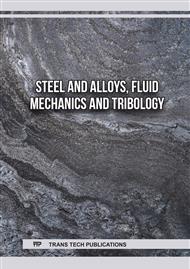[1]
M. Kole, S. Khandekar, Engineering applications of ferrofluids: A review. Journal of Magnetism and Magnetic Materials, 537 (2021), 168222.
DOI: 10.1016/j.jmmm.2021.168222
Google Scholar
[2]
J. Philip, Magnetic nanofluids: Recent advances, applications, challenges, and future directions. Advances in Colloid and Interface Science (2022) 102810.
DOI: 10.1016/j.cis.2022.102810
Google Scholar
[3]
R. E Rosensweig, An introduction to ferrohydrodynamics. Chemical Engineering Communications, 67(1) (1988) 1-18.
Google Scholar
[4]
B.M. Berkowsky, V.F. Medvedev, M.S. Krakov, Magnetic fluids: engineering applications. Oxford University Press, New York (1993).
Google Scholar
[5]
K. Vajravelu, K.V. Prasad, C.O. Ng, The effect of variable viscosity on the flow and heat transfer of a viscous Ag-water and Cu-water nanofluids. Journal of Hydrodynamics 25(1), (2013) 1-9.
DOI: 10.1016/s1001-6058(13)60332-7
Google Scholar
[6]
M. Mustafa, J.A. Khan, T. Hayat, A. Alsaedi, On Bödewadt flow and heat transfer of nanofluids over a stretching stationary disk. Journal of Molecular Liquids 211 (2015) 119-125.
DOI: 10.1016/j.molliq.2015.06.065
Google Scholar
[7]
M. Turkyilmazoglu, Bödewadt flow and heat transfer over a stretching stationary disk. International Journal of Mechanical Sciences, 90 (2015) 246-250.
DOI: 10.1016/j.ijmecsci.2014.10.022
Google Scholar
[8]
T. Halawa, A.S. Tanious, Investigation of the optimum design of magnetic field arrangement to enhance heat transfer performance of Fe3O4-water magnetic nanofluid. International Journal of Thermal Sciences 184 (2023) 108014.
DOI: 10.1016/j.ijthermalsci.2022.108014
Google Scholar
[9]
R. P. Gowda, R.N. Kumar, R. Kumar, B.C. Prasannakumara, Three-dimensional coupled flow and heat transfer in non-newtonian magnetic nanofluid: An application of Cattaneo-Christov heat flux model. Journal of Magnetism and Magnetic Materials 567 (2023) 170329.
DOI: 10.1016/j.jmmm.2022.170329
Google Scholar
[10]
D. Garg, V.K. Joshi, K. Sharma, S. Kumar, Effect of thermal radiation on Bodewadt flow in the presence of porous medium. Pramana 97(1) (2023) 16.
DOI: 10.1007/s12043-022-02483-z
Google Scholar
[11]
R. Nasrin, M.A. Alim, A.J. Chamkha, Effect of viscosity variation on natural convection flow of water–alumina nanofluid in an annulus with internal heat generation. Heat Transfer-Asian Research 41(6) (2012) 536-552.
DOI: 10.1002/htj.21016
Google Scholar
[12]
B. Sahoo, S. Abbasbandy, S. Poncet, A brief note on the computation of the Bödewadt flow with Navier slip boundary conditions. Computers & Fluids 90 (2014) 133-137.
DOI: 10.1016/j.compfluid.2013.11.020
Google Scholar
[13]
M. Abbaszadeh, A. Salehi, A. Abbassi, Lattice Boltzmann simulation of heat transfer enhancement in an asymmetrically heated channel filled with random porous media. Journal of porous media 20(2) (2017) 175-191.
DOI: 10.1615/jpormedia.v20.i2.60
Google Scholar
[14]
P.S. Reddy, A.J. Chamkha, Heat and Mass Transfer Characteristics of Al2O3− Water and Ag−Water Nanofluid through Porous Media over a Vertical Cone with Heat Generation/Absorption. Journal of porous Media 20(1) (2017) 1-17.
DOI: 10.1615/jpormedia.v20.i1.10
Google Scholar
[15]
R. Mehta, S. Jangid, M. Kumar, Comparative mathematical study of MHD mixed convection flow of nano-fluids in the existence of porous media, heat generation and radiation through upstanding equidistant plates. Materials Today: Proceedings, 46 (2021) 2240-2248.
DOI: 10.1016/j.matpr.2021.03.577
Google Scholar
[16]
S. Bhattacharyya, A.K. Sharma, D.K. Vishwakarma, V. Goel, A.R. Paul, Influence of magnetic baffle and magnetic nanofluid on heat transfer in a wavy minichannel. Sustainable Energy Technologies and Assessments, 56 (2023) 102954.
DOI: 10.1016/j.seta.2022.102954
Google Scholar
[17]
Y. Li, K. Fukuda, Q. Liu, M. Shibahara, Turbulent heat transfer with FC-72 in small diameter tubes. International Journal of Heat and Mass Transfer, 103 (2016) 428-434.
DOI: 10.1016/j.ijheatmasstransfer.2016.07.018
Google Scholar
[18]
C. Tangthieng, B.A. Finlayson, J. Maulbetsch, T. Cader, Heat transfer enhancement in ferrofluids subjected to steady magnetic fields. Journal of Magnetism and Magnetic Materials, 201(1-3) (1999) 252-255.
DOI: 10.1016/s0304-8853(99)00062-1
Google Scholar
[19]
M. A. Sheremet, M. A., M. S. Astanina, I. Pop, MHD natural convection in a square porous cavity filled with a water-based magnetic fluid in the presence of geothermal viscosity. International Journal of Numerical Methods for Heat & Fluid Flow, 28(9) (2018) 2111-2131.
DOI: 10.1108/hff-12-2017-0503
Google Scholar
[20]
P. Ram, V. K. Joshi, O. D. Makinde, A. Kumar, Convective boundary layer flow of magnetic nanofluids under the influence of geothermal viscosity. In Defect and Diffusion Forum, 387 (2018) 296-307.
DOI: 10.4028/www.scientific.net/ddf.387.296
Google Scholar
[21]
P. Ram, V. Kumar, Rotationally symmetric ferrofluid flow and heat transfer in porous medium with variable viscosity and viscous dissipation. Journal of Applied Fluid Mechanics, 7(2) (2014) 357-366.
DOI: 10.36884/jafm.7.02.20302
Google Scholar
[22]
J. L. Neuringer, Some viscous flows of a saturated ferro-fluid under the combined influence of thermal and magnetic field gradients. International Journal of Non-Linear Mechanics, 1(2) (1966) 123-137.
DOI: 10.1016/0020-7462(66)90025-4
Google Scholar
[23]
H. Schlichting, K. Gersten, Boundary-layer theory, (2016) springer.
Google Scholar
[24]
M. Rahman, H.I. Andersson, On heat transfer in Bödewadt flow. International Journal of Heat and Mass Transfer, 112 (2017) 1057-1061.
DOI: 10.1016/j.ijheatmasstransfer.2017.05.024
Google Scholar


